Introduction
Nutrient density – that’s a term I used fairly frequently, but took for granted for a long time. I hadn’t really thought about exactly what it meant until the past few months. First – a story:
A few months back I was out with some friends that I met with regularly (ulti fris team!), and the topic of food and nutrition had been coming up. Within the group was a vegan, who was notably very respectful and not too vocal about being vegan, but after ordering food it was obvious, and some questions were asked. It was all well and good, until the subject of protein was broached, and someone mentioned that you can eat broccoli for protein as a vegan/vegetarian, and that the amount of protein you get is similar to beef. As a nutrition junkie, that sounded like pure garbage to me, so I simply disagreed that broccoli was a good source of protein, while she insisted it was. I let it go because I wanted things to be friendly and I knew I was right, but I did leave that situation wondering where in heavens that otherwise smart person got that idea, so I Googled it up.
Turns out, as some of you may already know, there’s a man named Dr. Fuhrman who published that precious little broccoli-beats-beef tidbit. Dr. Fuhrman is the author of Eat to Live, which is a book that, while I haven’t read it, recommends what he has classified as a “nutrient dense diet”, which is centred around the idea of “nutrient density” as a measurable food characteristic. I was definitely puzzled and shocked by the specific broccoli statement, but at first glance, the general idea behind nutrient density seemed plausible. Who doesn’t want foods that are nutrient dense? I want nutrients! And lots of them! Then I started thinking….what does that even mean? In what context does it even matter? Which nutrients are we talking about?
I did some research, and found out that another scientifically oriented Primal/Paleo adherent named Mat Lalonde had been asking similar questions a few years ago. He did a literature review of different definitions of nutrient density, and then provided his own analysis, which I think is pretty good, albeit limited (he fully admits the limitations). He presented his work at the 2012 Ancestral Health Symposium.
In this two-part article, I’ll first be looking at the two different methods of determining nutrient density of foods (Fuhrman and Lalonde styles), and then in the second part I’ll provide some of my insights.
Before I get into an analysis of the work, and the concept of nutrient density in general, first a bit of a nutrients primer (will be review to some).
Nutrients Primer
So what is a nutrient? How is it different from just food? Nutrients come in two forms: 1. macronutrients, and 2. micronutrients. Macronutrients we consume in macro amounts – an amount that is large enough to see with the naked eye. Micronutrients come in micro amounts – amounts so small that we can’t actually see them. Macronutrients are what provide energy and a lot of the structure of the body, while micronutrients regulate processes. There are three main macronutrients, with one that is entirely optional:
Macronutrients:
- Proteins – made up of amino acids. Supply 4 kcal energy per gram.
- Fats – made up of fatty acids. Supply 9 kcal energy per gram.
- Carbohydrates – made up of sugars. Supply 4 kcal per gram.
- Alcohol – optional
 Supplies 7 kcal per gram.
Supplies 7 kcal per gram.
Proteins and fats are essential to the body, so you will die without very specific amino acids and fatty acids. These are called essential amino acids, and essential fatty acids. Even with enough food energy coming in, you’ll die without these essential nutrients in adequate quantities. Carbohydrates and alcohol are not required for survival. Carbohydrates can be beneficial, however, while alcohol is completely unnecessary (for most ;-).
Micronutrients are more complicated. Micronutrients are your vitamins, minerals, and whole bunch of other chemicals we get in small amounts. Some we need to survive, and some are optional, but are generally beneficial. They regulate tissue function and support metabolism, for the most part. There are also a bazillion chemical compounds that don’t seem to be essential, but potentially beneficial while also being a big mystery as to their primary function (a lot of the ‘phytochemicals’ you might hear about fall into this category).
That’s the primer! Back to the real article.
The Fuhrman Definition of Nutrient Density
According to Dr. Fuhrman, the definition of nutrient density is as follows:
Nutrient Density = Micronutrients / Calories
While that’s the basis, it’s actually more complicated than that, where certain micronutrients are valued higher than others, and certain micronutrients are completely excluded. To Dr. Fuhrman’s credit, this does make intuitive sense. You have to eat a certain amount of calories to support your metabolism, and within those calories that you take in, you do need to meet your micronutrient goals. That I like. It’s clearly true, but as I’ll explain below, I think he takes that concept too far in how he ranks foods.
During Mat Lalonde’s presentation at the Ancestral Healthy Symposium in 2012, he presented a slide that shows the Fuhrman calculation that creates his ANDI (aggregated nutrient density index) score, which is below. Essentially, I think he added up all the nutrients in the “included” categories for a given serving size, and divided by the number of calories in that same serving.
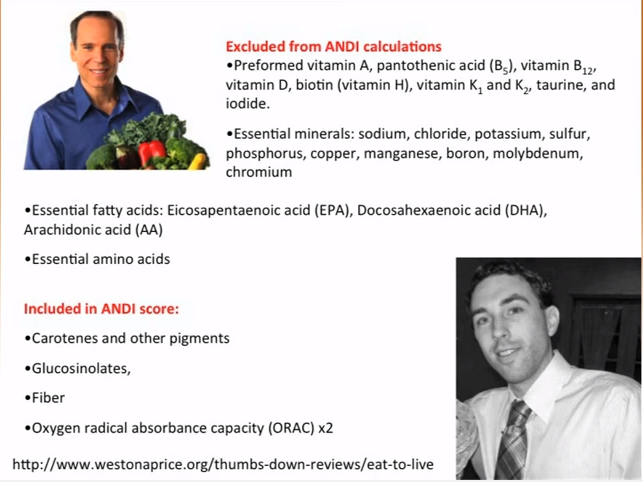
Looking at this list, there is a nutrient (not stricly micro, mind) selection bias in his ANDI score that neglects the essential amino and fatty acids, which makes me very skeptical to begin with. He’s also arbitrarily doubling the weight of the oxygen radical absorbance capacity (ORAC – which is a measurement of a food’s antioxidant level), which is definitely not based in science (why double? Where did he come up with that?). On top of that, the basis of his nutrient density is divided by the number of calories in the food, which means that foods that are rich in calories will be ranked low even if they do provide substantial micronutrients. To me, this seems very strange, since as discussed in the primer, proteins and fats are essential to the body, and they also provide calories. So how can we take this ANDI scale seriously? Foods that provide essential amino and fatty acids are penalized for doing so? And even for the non-essential fats and proteins, I mean, human bodies need energy!
Also – as I’ve talked about before, a lot of plant-based foods (mostly grains and legumes) contain anti-nutrients that prevent the efficient absorption of nutrients in those foods, and thus lower the bioavailability of those nutrients, and this is completely ignored by Dr. Fuhrman. Not to mention the fact that many plant-based nutrients require a conversion in the human body to be useful (examples: heme iron vs non-heme iron, vitamin A precursors to retinol, plant based omega-3 to animal form), and most people are tragically inefficient at these processes, so plant based nutrients are sometimes not as helpful as animal based ones: again ignored. I sense a bias…
Due to his specific nutrient selection and calculation methods, foods that have a high amount of his chosen micronutrients and low amounts of calories score high. What’s at the top? Kale, collard greens, bok-choy, and the like. Nutritious foods, to be sure, and I completely agree that these foods are worth eating. At the bottom, however, are eggs, meats, dairy, and all other animal foods foods, closer to cola than they are to mangos! Like, seriously – kale ranks at 1000 on the scale, and ground beef is 20. 20?! Come on! Here is the whole scale.
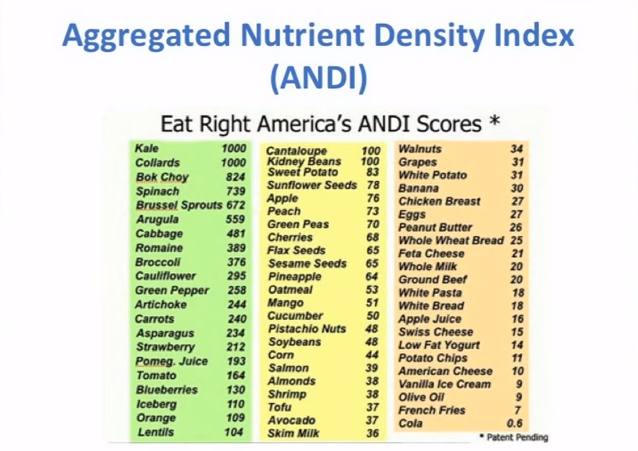
His ranking system combined with his insistence that the majority of our foods should come from the top of the list provide the basis for his somewhat controversial dietary guidelines:

This may look healthy at first glance, and maybe it could be, but how much physical food does this work out to? For me, at 6’2″ and a reasonably lean 215 lbs, I burn about 3,000 calories a day, so the vegetable-based calorie recommendation is 1,000-1,800 calories a day. At the low end of this recommendation, 1,000 calories, according to the USDA Nutrient Database, that would require either 2.9 kg (6.5 lbs) of raw broccoli, 2.0 kg (4.5 lbs) of raw kale, 4.0 kg (8.8 lbs) of raw cabbage, or 4.3 kg (9.6 lbs) of raw spinach.
Using kale, which happens to be the most calorie dense of these veggies, this still works out to about 30 cups…which hardly seems practical, and made me recheck my calculations three times! Can that even be right? Who in their right mind would ever eat that much kale in one sitting? Let alone every freaking day? And then we need to eat fruits, beans, nuts, and grains too? Woah.
Trying to get the bulk of your calories from extremely low-calorie vegetables doesn’t seem to make sense…you’d spend the whole day eating, would you not? Maybe if you blend them up it’s faster, but still! How are you going to fit all that in? And that much kale would provide about 4,000% of your daily vitamin C recommendation, which seems to me like an unnecessarily massive dose. Why not eat just a bit of this “nutrient dense” kale to provide the precious micronutrients in the right amounts, and then some more energy (calorie) dense foods with fats, carbs, and proteins, like a normal person?!
I think in some situations, Dr. Fuhrman’s thinking can be helpful (going easy on junk food in favour of more nutritious foods), but taken to this extreme it could be potentially harmful. Focusing on absurd amounts of only the most high-nutrient/low-calorie foods could easily lead to extreme under-eating, calorie wise. We have to remember that macronutrients, which provide calories, are still nutrients that are required by the human body! Penalizing foods for containing carbs, fats, and proteins is a little ridiculous, but I digress. I’ll get more into this later.
Debunking the Broccoli is Better than Beef Statement
OK – it is time to delve into the infamous “broccoli contains more protein than beef” statement. His book states that a 100 calorie portion of sirloin has 5.4 g of protein, while a 100 calorie portion of broccoli has 11.2 g of protein. Well, according to the USDA Nutrient Database again, 100 calories of sirloin (trimmed to 0% fat and broiled) contains 13.8 g of protein, while the 100 calories of broccoli contains 8.3 g.
SO – that statement is wrong, but I mean, 8.3 g is still actually pretty close to 13.8 g, so it can look pretty surprising and even convincing that broccoli is a good source of protein, and even comparable to beef. Remember though, this is an equal calorie portion. What does 100 calories of broccoli look like compared to 100 calories of beef?
100 calories of broccoli – 294 g, or 3.2 cups (91 g per cup) – 8.3 g protein
100 calories of beef sirloin – 47.2 g, I don’t know how many cups, but this is a tiny portion – not even 2 oz…for me, this is literally 2-3 bites of beef, and nets 13.8 g of protein.
To take this further, if you want a reasonable 30 g serving of protein, you’ll need 1,062 g of broccoli (11.7 cups) or 103 g of beef, which is literally 5-6 good-sized bites.
SO – which appears to be a better source of protein to you? Practically speaking, it’s clearly the beef. And this doesn’t even take into account the quality of the protein (how much of the essential amino acids you get…).
To bring the point home even more, some friendly folks over at Ancestralnutrition.com calmly explain that when it comes to supplying the right mix of essential amino acids, it would take a impractically-huge mound of broccoli to even come close to what beef can provide in a few bites. The vitamins and minerals in broccoli are great and all, but beef has vitamins and minerals too, and is a much better source of protein, period.
This is why basing the “nutrient density” definition on calories in a food doesn’t always work…I feel like within the separate categories of calorie-poor or calorie-rich foods, you could make a comparison this way, but comparing broccoli to steak on a per-calorie basis just inflates broccoli’s nutritional status, and makes steak look useless, which is completely false. Nobody eats broccoli “for the calories”, or “for the protein”. It’s just too calorie and protein poor. This is an impractical system. Steak and broccoli are very different foods!
To me, nutrient density should be based on practical serving sizes, not calories. As mentioned above, Mat Lalonde has already done quite a service in looking at the concept of nutrient density, which I’ll touch upon in the next section.
Mat Lalonde’s Work on Nutrient Density
While researching this article, and as mentioned above already, I came across work by Chemist Mat Lalonde that was presented at the 2012 Ancestral Health Symposium (a Paleo wonderland, of which I am admittedly a fan).
He took all the data freely available on the USDA National Nutrient Database for Standard Reference, and performed a sophisticated statistical analysis for nutrient density. His definition is very different. He bases it on actual known essential micronutrients (based on the data that was available, but was incomplete, as he fully admits), and doesn’t scrutinize by calorie count, but by serving weight (or mass). So instead of dividing by the number of calories you get in a serving, he divides the micronutrient levels by the mass of the serving in grams (g). To me, this is more intuitive, as it’s strange to think of measuring out calories, but quite simple to think of measuring out a certain weight/mass of a food.
Mat also explains, to my science-nerd glee, that both the Furhman and his own Nutrient Density calculations does not provide an actual “density” according to the word’s definition, but rather a “concentration”, as density is defined as Mass/Volume, and volume is not taken into account at all! He still calls it nutrient density after for simplicity, as this is a term that people are already familiar with. Also, he separates “Nutrient Density” from “Caloric/Energy Density”, which I think is a better way to go. This essentially separates micronutrient and macronutrient content, and analyzes them separately, based on mass of serving. Nice.
Here is his nutrient density calculation (crossed out words were data that were not available):
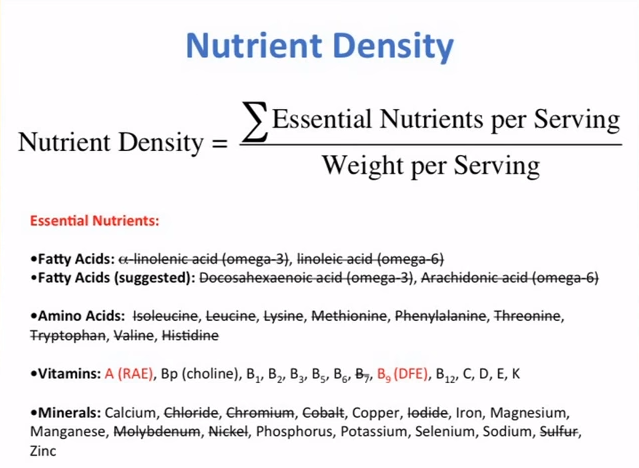
Again, no essential fatty acids or amino acids because that data was not available. Had it been, he would have certainly used it. However, at least the micronutrients are all essential (missing a few, mind…), and there’s no mystery “phytochemicals” in the mix, only the known essential vitamins. ALSO – the vitamin A being analyzed is the Retinol-Activity-Equivalent, which means it’s the effective dose of the animal-based vitamin A (retinol), which takes into account the weak conversion of the plant based version to retinol. Using this method, the results are, I believe, much more reasonable:
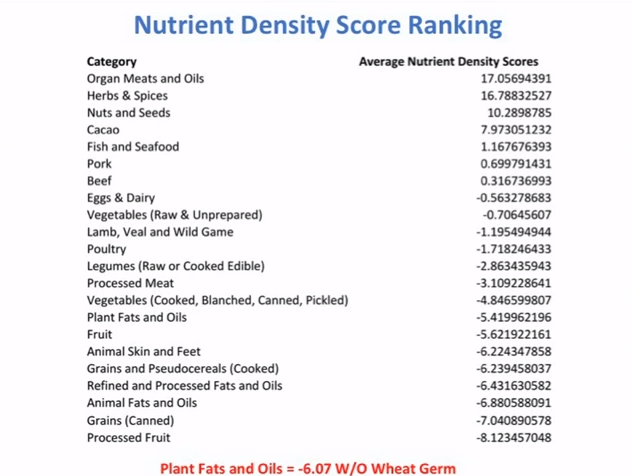
This is more what I would have expected. Look at those organ meats and herbs & spices go! I think if Mat had even more data included, things would be different, but not that different. Again – this only includes the nutrients shown above, so there could be a lot of non-essential but beneficial nutrients that could tip the scales in a different direction a bit, but I still believe this is more reasonable than Fuhrman’s analysis.
Mat doesn’t provide a dietary guideline in his work, but during the question period after, he does caution about eating too high on the list too often: you can get toxic amounts of some nutrients if you don’t take it easy on those foods! Just because animal organs are extremely nutritious doesn’t mean that’s all you should be eating. That would also be impractical (and gross)! Perhaps these extremely “nutrient dense” foods are meant to be eaten in relatively small quantities, and not as the basis of the human diet. The rest of the diet can easily be filled out with more energy-dense foods, that hopefully still contain a decent amount of micronutrients (I’m definitely not recommending pure flour or sugar as the rest of your diet…normal meats, veggies, tubers, nuts/seeds, and fruits will do just fine and are vastly superior).
Here is Mat’s entire presentation:
OK! This article got really long, so I’m going to end it here. In my next article in this series, I’ll present my own mini-analysis into nutrient density, and show how I think that there really can’t be one definition of nutrient density that ranks all types of foods appropriately. So many foods are just so different, that it may be an overall bogus concept!
Until then – your thoughts, readers?
PS: Eat your veggies! They’re good for you. Just don’t think that they are providing you much protein, haha.
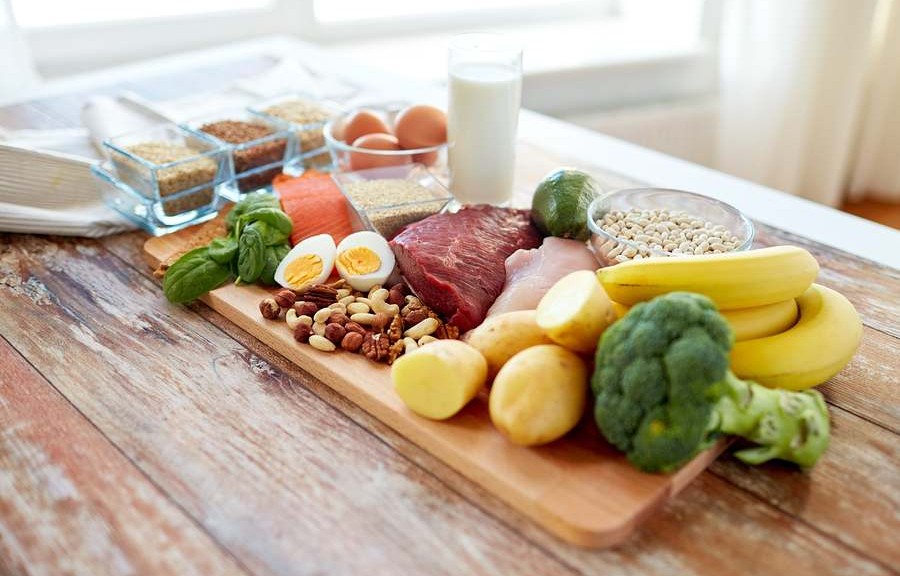
Great read! Also, I hate Broccoli.
Oh c’mon – covered in cheese and bacon it’s delicious 😉
Thanks for the comment!
“For those of you eating egg white omelettes, I’ll take the yolk”! lol
Great article – been hearing the brocco>beef argument getting loosely thrown around – glad I have some back-up to shut pple down now.
Hey Dave!
Thanks for the comment. Broccoli is in my good books, but there is no way it is a good source of protein.
Cheers!
“For those of you eating egg white omelettes, I’ll take the yolk”! lol
Great article – been hearing the brocco>beef argument getting loosely thrown around – glad I have some back-up to shut pple down now.